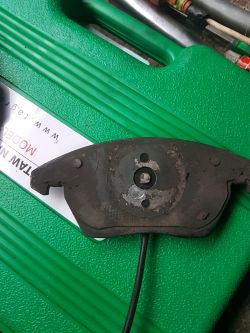FAQ
TL;DR: Golf V front-left knock over bumps? "99% swingarm pin" and hard to check under load; use this checklist to confirm fast. [Elektroda, DriverMSG, post #17123935]
Why it matters: Helps Golf V owners quickly pinpoint knocks without replacing parts blindly, improving safety and saving cost.
Quick Facts
- Symptom pattern: knock only when the left wheel hits small holes at low speed; silent otherwise. [Elektroda, kenumo, post #17123366]
- Common culprit: lower control arm ball joint; under spring load play hides, then knocks when slack. "99% swingarm pin." [Elektroda, DriverMSG, post #17123935]
- Checklist: engine/gearbox mounts, brake mounts (pads/disc), spring seating, and driveshaft joints. [Elektroda, DriverMSG, post #17124394]
- This thread’s fix: damaged pad retaining spring in caliper piston; new brake pads resolved the knock. [Elektroda, kenumo, post #17133056]
- Tie-rod ends need a helper moving the steering at a standstill to assess play. [Elektroda, DriverMSG, post #17124440]
What’s the most common cause of a Golf V front-left knock over bumps?
The lower control arm ball joint is a prime suspect. It is difficult to spot when the suspension is spring‑loaded. It can make loud knocks once slack appears. “99% swingarm pin.” [Elektroda, DriverMSG, post #17123935]
My Golf V knocks only at low speed when the left wheel hits small holes. What does that suggest?
That pattern points to a single loose part reacting to sharp inputs. The owner reported silence while cruising, but knocks on small holes. Focus on the left-front corner first. Then verify joints, brake mountings, and hardware there. [Elektroda, kenumo, post #17123366]
Could bad brake pad hardware cause suspension-like knocking?
Yes. In this case, a damaged brake pad retaining spring inside the caliper piston caused the noise. The spring let the pad move and knock over bumps. The post shows the damaged part. Quote: “damaged handle/spring of the brake pad.” [Elektroda, kenumo, post #17133054]
What exactly fixed the issue in this thread?
Replacing the front brake pads eliminated the knock completely. That included fitting correct hardware in the caliper piston. “After replacing the brake pads, the problem was gone.” [Elektroda, kenumo, post #17133056]
How do I check the tie-rod end (steering rod tip) correctly?
“You will not check yourself, you need someone to help you with the steering wheel at a standstill.” 1. Park safely and chock wheels. 2. Have a helper rock the steering left–right. 3. Watch inner and outer tips for play or clunks. Replace any joint showing delay or movement. [Elektroda, DriverMSG, post #17124440]
What else should I inspect beyond shocks and links?
Inspect engine and gearbox mounts for play. Check brake mounts, including pads and discs, for looseness. Verify the spring sits correctly in its seats. Check driveshaft joints for play and noise. These items often mimic suspension knocks. [Elektroda, DriverMSG, post #17124394]
Should I check the subframe (“sled”) mounting bolts?
Yes. Loose subframe bolts can transmit knocks into the cabin. Inspect the mounting points and service hardware as needed. “Tighten or replace the screws.” Replace stretch bolts during subframe service to maintain clamping force. [Elektroda, DriverMSG, post #17124440]
Should I have the driveshaft joints checked too?
Yes. Have a technician inspect the driveshaft joints while the car is on a jack. “By the way, on the jack, ask to check the driveshaft joints.” Play here can present as a knock on bumps. [Elektroda, DriverMSG, post #17124540]
The diagnostic station said everything is OK, but I still hear a knock. Now what?
Get a second inspection and request a targeted check of mounts and brake hardware. One station may miss play that another finds. “It is different at the stations.” Ask for a road test over uneven surfaces. [Elektroda, helmud7543, post #17124529]
Can non-suspension parts mimic a stabilizer link knock?
Yes. A loose engine-bay component can sound identical to a worn stabilizer link. A cited case was a gas filter tapping the valve cover at low speeds. Verify clearances and mountings around the engine. [Elektroda, helmud7543, post #17124529]
I already replaced two front shocks, yet the knock remains. What does that tell me?
Two new shocks were installed here, and the knock persisted. That points away from dampers and toward mounts, joints, or brake hardware. Redirect diagnosis before replacing more parts. [Elektroda, kenumo, post #17123366]
Why can a worn ball joint be missed during routine checks?
Load can mask play when the car sits on its wheels. Movement shows only when the joint is unloaded or slack increases. The noise may still be loud on bumps. [Elektroda, DriverMSG, post #17123935]
Could a hub or bearing job cause a new knock?
Yes. During hub service, pad hardware can be damaged or omitted. In this thread, the pad spring in the piston was compromised. Knocking stopped only after new pads were fitted. [Elektroda, kenumo, post #17133054]



